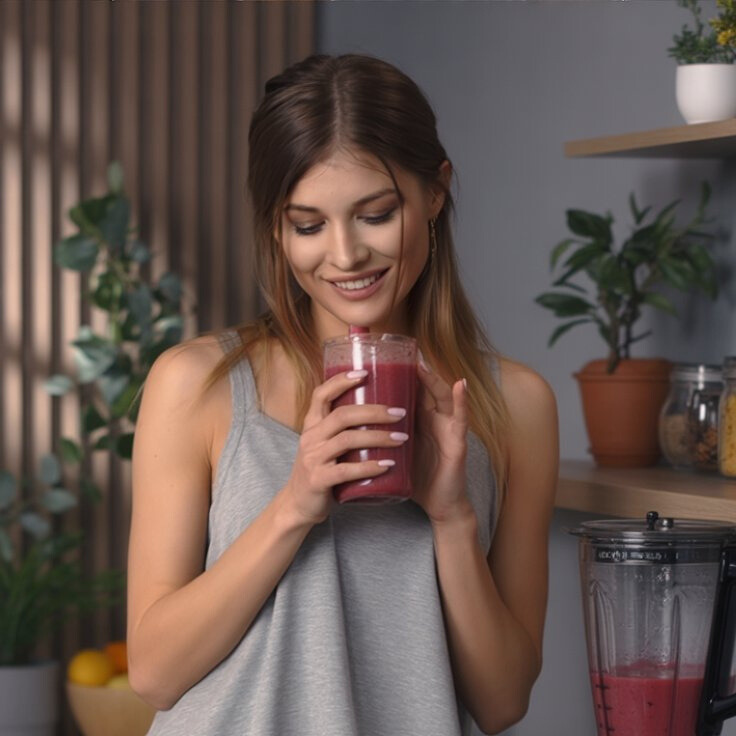Are Smoothie Diets Healthy? What Beginners Need to Know
Are smoothie diets good for you? Discover the benefits, risks, and a simple beginner guide.
HEALTH
11/14/20253 min read


Are Smoothie Diets Healthy? A Simple Guide for Beginners
Your friendly, science-backed look at whether smoothie diets are actually good for you.
Smoothie diets have become one of the biggest wellness trends of the last few years — and honestly, it’s pretty easy to see why. They’re colorful, they taste amazing, they’re packed with nutrients, and they make you feel like you’re doing something good for your body.
But are smoothie diets actually healthy? Can they help with weight loss? And is it safe to replace meals with smoothies for a few days (or even a few weeks)?
Let’s break it all down in a simple, beginner-friendly way — without the complicated nutrition lessons.
What Exactly Is a “Smoothie Diet”?
A smoothie diet usually means replacing one or two daily meals with nutrient-packed smoothies made from whole foods like:
Fruits
Vegetables
Greens
Plant-based milk
Protein powder
Healthy fats (chia, flax, avocado, nuts)
Some versions have you replace all meals for a short period. Others (which most nutritionists prefer) include smoothies + light, balanced meals.
There are many styles, but most of them focus on:
✓ boosting nutrients
✓ reducing processed foods
✓ improving digestion
✓ cutting back on sugar-heavy or fatty meals
Simple, right?
Are Smoothie Diets Actually Healthy?
Short answer: yes — if you do them properly.
Smoothies can be incredibly healthy because they’re usually packed with:
Vitamins
Fiber
Antioxidants
Hydration
Good carbs
Healthy fats
But the key phrase is: when done properly.
Healthy smoothie diets include:
Fresh or frozen whole foods
Protein sources (Greek yogurt, whey, plant protein)
Healthy fats
Greens
Low added sugar
Unhealthy smoothie diets include:
Only fruit (too much sugar)
No protein (causes hunger + muscle loss)
All liquid meals for too long
Store-bought sugary smoothies
So, the smoothie diet itself isn’t the issue — the recipe is.
Health Benefits of a Smoothie Diet
If done correctly, people often experience:
1. Weight Loss (Naturally)
Smoothies help reduce calorie intake while still giving your body nutrients.
Plus, blending fiber keeps you fuller longer.
2. Better Digestion
Green smoothies = your gut will thank you.
Fiber + hydration is powerful for digestion and bloating.
3. More Stable Energy
Because smoothies release sugars more slowly than fruit juices, you avoid energy crashes.
4. Easier Way to Eat More Fruits & Veggies
Let’s be honest — most people don’t eat enough veggies.
A smoothie is an easy fix.
5. Better Skin + Hydration
The vitamins, antioxidants, and water content help clear skin and support overall glow.
Are There Any Downsides?
Only a few — and they’re easy to avoid.
1. Not Enough Protein
Smoothies made only from fruit won’t keep you full.
➜ Fix: add protein powder, yogurt, or nut butter.
2. Too Much Fruit Sugar
Fruit is healthy but can spike blood sugar.
➜ Fix: balance fruit with greens + fat + protein.
3. Using Smoothies as a Long-Term Meal Replacement
Most experts don’t recommend replacing every meal for months.
➜ Fix: follow a structured plan (like a 21-day program).
So… Should You Try a Smoothie Diet?
If you want something:
easy
nutritious
full of variety
beginner-friendly
and great for weight loss
Then yes — a smoothie diet can be an excellent choice.
Just make sure it’s structured and not random “throw fruit in a blender” meals.
Most beginners have the best results with a guided 21-day smoothie plan, because it takes the guesswork out of nutrition and gives you balanced recipes.
Beginner Tips Before Starting a Smoothie Diet
Here are simple, keep-it-real tips your readers will appreciate.
1. Add Protein to Every Smoothie
This is the difference between feeling full or starving.
2. Use Greens for Volume
Spinach and kale blend well and add nutrients without changing the taste.
3. Keep It Simple
You don’t need 20 ingredients.
Often the best smoothies have 4–6 items.
4. Prep Smoothie Bags
Freeze ingredients in zip bags.
In the morning, just blend.
5. Drink Slowly
Smoothies digest better when you sip, not gulp.
Sample Day from a Healthy Smoothie Diet
Here’s an example you can include for value:
Morning Smoothie
Green Power Glow
Spinach
Banana
Pineapple
Greek yogurt
Flax seeds
Almond milk
Lunch Smoothie
Berry Protein Blend
Mixed berries
Vanilla protein
Chia seeds
Oats
Coconut water
Dinner
Light meal (example: baked chicken + veggies)
Snack
Handful of nuts or a small apple
Final Thoughts
A smoothie diet can absolutely be healthy — if you follow a balanced plan and include proteins, greens, and healthy fats, not just fruit.
For beginners, a structured approach is best because it guides you day by day, removes confusion, and helps you get real results.
If you want to try one, here’s the link again:
👉 Check out this 21-Day Smoothie Diet for easy recipes and step-by-step guidance.
Healthy, simple, and honestly — pretty delicious.


Contact
Follow
info@adorelife.net
© 2025. All rights reserved.